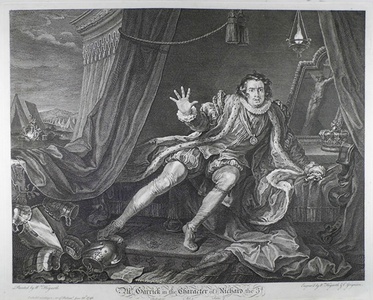| Method | Copper engraving and etching |
| Artist | William Hogarth and Charles Grignion after William Hogarth |
| Published | Painted by Wm. Hogarth. Engrav'd by Wm. Hogarth & C. Grignion. Publish'd according to Act of Parliamt. June 20th. 1746. [J & J Boydell c.1795] |
| Dimensions | Image 388 x 505 mm, Plate 422 x 529 mm, Sheet 470 x 645 mm |
| Notes |
A superb engraving of the actor David Garrick in his celebrated lead role in Shakespeare's Richard III, performed at Goodman's Fields on the 19th of October, 1741. Garrick was a close friend of Hogarth's, and one of greatest supporters. Aside from purchasing Hogarth's Election paintings and acting as an advocate for the artist in London society, it was Garrick that ultimately penned the inscription for Hogarth's tombstone, which lauded him as the 'Great Painter of Mankind.' The scene depicted in the engraving is Act 5, Scene 3, as Richard awakes from a haunting dream in his tent just before the Battle of Bosworth Field. The king's armour rests against an ivy-covered pillar in the bottom left corner, his helmet's crest featuring the boar of York resting on a scrap of Norfolk's letter. The opulence of the king's clothing, daybed, drapery, and tent speak to his majesty and importance. At the head of his daybed, the crown rests on a small sidetable before a framed image of the crucifixion. Aside from celebrating the first major success of a close personal friend and the career beginnings of the greatest actor of the age, Hogarth's rendering of the scene also speaks volumes to his skill as a grand history painter, with the King's figure following the 'serpentine' line of beauty that Hogarth so favoured. The inscription below, in Gothic lettering, reads: 'Mr. Garrick in the Character of Richard the 3d: Shakespear Act 5. Scene 7 [sic].' William Hogarth (1697 - 1764) was born in London, the son of an unsuccessful schoolmaster and writer from Westmoreland. After apprenticeship to a goldsmith, he began to produce his own engraved designs in about 1710. He later took up oil painting, starting with small portrait groups called conversation pieces. He went on to create a series of paintings satirising contemporary customs, but based on earlier Italian prints, of which the first was The Harlot's Progress (1731), and perhaps the most famous The Rake's Progress. His engravings were so plagiarised that he lobbied for the Copyright Act of 1735, commonly referred to as 'Hogarth's Act,' as a protection for writers and artists. During the 1730s Hogarth also developed into an original painter of life-sized portraits, and created the first of several history paintings in the grand manner. Paulson 165 ii/ii Condition: Water stain to left side of sheet, slight surface dirt to sheet margins, minor tear repairs to left sheet edge. |
| Framing | unmounted |
| Price | £400.00 |
| Stock ID | 38036 |

